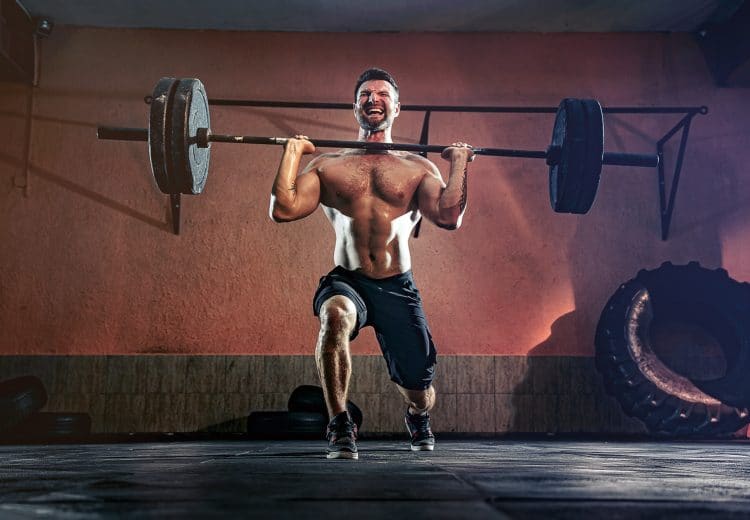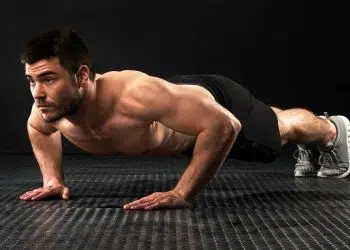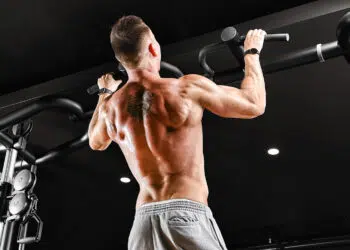You are only as strong as your last workout. If you want to get stronger (or more muscular, for that matter), you need to train a little harder from one week to the next. Depending on your preferences, this could mean lifting more weight, doing more reps, taking shorter breaks between sets, doing more sets, or a combination of these factors.
As the weeks pass, your muscles will respond to these increases by getting stronger.
If you don’t make your workouts gradually more demanding, your body has no reason to change. Instead, it needs to be bullied into getting stronger with ever more challenging workouts.
However, all good things must come to an end, and eventually, you won’t be able to add more weight to the bar or do more reps. You’ll hit a plateau.
The good news is that there are several things you can do to get unstuck and reignite your progress.
One way to get back on the gains train is by incorporating deadstop training into your workouts.
Level Up Your Fitness: Join our 💪 strong community in Fitness Volt Newsletter. Get daily inspiration, expert-backed workouts, nutrition tips, the latest in strength sports, and the support you need to reach your goals. Subscribe for free!
In this article, we explain what dead stop training is, how to do it, and provide you with some great exercises to try.
What is Dead-Stop Training?
Most exercises involve two distinct phases – lifting and lowering. Lifting a weight involves a concentric contraction, meaning your muscles shorten under tension. Lowering a weight involves an eccentric contraction, where your muscles lengthen under tension.
Some exercises start with a concentric contraction (e.g., deadlifts, lat pulldowns, pull-ups, leg extensions, biceps curls). In contrast, others begin with an eccentric contraction (e.g., squats, bench presses, leg press, lunges).
The transition between lifting and lowering a weight (or lowering and lifting) activates something called the stretch-shortening reflex, or SSR for short.
The SSR provides an elastic band-like bounce that makes it a little easier to perform your chosen exercise. The faster you do your reps, the more the SSR comes into play, which is why it’s usually easier to lower and then lift a weight quickly.
To understand the stretch-shortening reflex, imagine you are about to do a jump. You squat down and then extend your legs to leap into the air. The faster you descend, the more powerful the SSC will be, and the higher you’ll be able to jump. In contrast, if you descend slowly and then pause, invariably, you won’t be able to jump as high because the SSR won’t be as powerful.
While the SSR is useful for increasing force generation, when it comes to training, easier is rarely better. In fact, if you can avoid triggering the SSR, your workouts will be harder and potentially more productive. As a result, every rep will be more reliant on muscle strength and not the elasticity of your tendons.
Deadstop training reduces the stretch-shortening reflex, forcing you to work harder. You’ll get stronger faster and see noticeable improvements in your performance when you return to regular-style training.
As an added benefit, dead stop training is also good for your joints. Eliminating the SSR means less stress on your tendons and the articular surfaces.
As such, if you’re feeling a little beaten up, a few weeks of dead-stop training could mean you continue gaining strength while giving your joints a well-earned break.
Finally, dead-stop training could help you bust through a bodybuilding plateau. Your body is the master adapter and will stop growing if the demands of your workouts don’t change from time to time. Dead-stop training works your muscles in a unique way, and that could be just what’s needed to re-trigger hypertrophy.
Related: Must-Have Dead Stop Exercises To Improve CrossFit Performance
How to Do Dead-Stop Training
While the science behind the stretch-shortening reflex is quite complex, involving stretch receptors, Golgi tendon organs, muscle spindles, and a whole bunch of other science stuff, the practice of dead-stop training is actually pretty simple.
In a nutshell, you deliberately pause between the eccentric and concentric phases of your chosen exercise so that the SSR remains untriggered.
However, this is different from traditional paused reps, where your muscles stay under tension and the midpoint of each rep. Instead, you want to partially or even completely unload your muscles, so each rep is broken by a true dead-stop.
For clarity, let’s compare paused bench presses with dead-stop bench presses.
To do paused bench presses, you lower the bar to within an inch of your chest and hold it there for a couple of seconds before driving the bar back up. But, for dead-stop bench presses, you lower the bar until it’s resting on the safety bars in a power rack. Then, after briefly unloading your muscles, you drive the bar back up.
Both types of training are effective, but they’re clearly different, too.
In most cases, dead-stop training means using a power rack, blocks, or some other form of support to take the weight at the mid-point of your rep. In contrast, paused reps usually require no additional equipment.
Level Up Your Fitness: Join our 💪 strong community in Fitness Volt Newsletter. Get daily inspiration, expert-backed workouts, nutrition tips, the latest in strength sports, and the support you need to reach your goals. Subscribe for free!
Note:
Some dead-stop exercises start with the weight resting on supports, while others involve a dead-stop at the mid-rep point. Both variations are effective and, with some exercises, it’s up to you to choose which variation you do. If available, try both options and see which one you prefer.
Example dead-stop exercises include:
1. Dead-Stop Squat
This exercise is good for developing power “out of the hole.” As such, it’s a popular exercise with powerlifters. You can do dead-stop back squats or front squats as preferred.
How to do it:
- Set the safety bars on a power rack, so they’re at the bottom of your squat.
- Unrack the bar as usual and brace your core.
- Squat down until the bar is resting on the pins. Allow the weight to settle for a second or two.
- Explode up off the pins and then descend into another rep.
You can also start this exercise with the bar resting on the pins, which is called an Anderson or bottoms-up squat.
2. Dead-Stop Bench Press
A lot of benchers are guilty of bouncing the bar off their chests. This not only triggers the stretch-shortening reflex but also uses the elasticity of the shoulder joint capsule and rib cage to lift the weight. Dead-stop bench presses eliminate all these aids, making each rep much harder, more productive, and safer, too.
How to do it:
- Set the safety pins in a squat rack so that they’re level with your chest. Lie on the bench, pull your shoulders down and back, brace your core, and drive your feet into the floor.
- Unrack the barbell as usual and then lower it down until it’s resting on the pins.
- Pause for a second or two, and then drive it back up.
- Alternatively, you can start each rep with the bar resting on the pins.
3. Dead-Stop Shoulder Press
Shoulder and military presses are great deltoid exercises but can also be hard on your joints. Dead-stop shoulder presses are much more joint-friendly and, without using the SSR, a useful strength-building exercise.
How to do it:
- Set the safety bars in your power rack to about shoulder height and rest your barbell on the pins.
- Using your normal shoulder press stance and grip, press the bar up and off the pins to arms’ length.
- Lower the bar back to the pins, let it settle for a second or two, and repeat.
4. Dead-Stop Lateral Raise
It’s all too easy to use momentum during lateral raises, especially if you inadvertently go too heavy. This dead-stop variation makes cheating all but impossible and also takes some stress off your hard-working shoulder joints.
How to do it:
- Sit sideways on a flat exercise bench. Hold a dumbbell in each hand with your arms straight and the weights resting on the bench.
- Raise the dumbbells up and out to shoulder height.
- Lower them back to the bench, let the weights settle for a second or two, and then repeat.
5. Pendlay Row
Bent-over rows are a tremendous back-building exercise, but they can be hard on your lower back and grip. Pendlay rows involve starting each rep with the barbell resting on the floor, so they’re also known as dead-stop rows.
This mid-rep pause gives your lower back and grip with a welcome rest. Also, you’ll need to work harder to initiate each rep, as you won’t have the SSR to help you.
Learn more about Pendlay rows here.
You can also do dead-stop single arm rows, which are just as effective but even easier on your lower back.
6. Seated Barbell Curl
Barbell curls are one of the most poorly performed exercises. Lifters use their legs and backs to lift the weight, taking stress off the target muscles. Seated barbell curls not only stop you from swinging the weight up, but they also eliminate that pesky SSR, making each rep considerably harder than usual. You can do this exercise with a straight or EZ barbell.
How to do it:
- Sit on an exercise bench with your feet flat on the floor and your torso upright. Rest a barbell across your thighs and hold it with an underhand, shoulder-width grip.
- Without using your torso, bend your arms and curl the weight up to your shoulders.
- Lower the bar back to your legs, let the weight rest there for a second or two and then repeat.
7. Dead-Stop Dips
Dips are a controversial exercise. On the one hand, they’re a very effective chest and triceps builder. But, on the other, they can be hard on your shoulders, especially if you descend too far.
Dead-stop dips involve descending until your feet (or knees) touch the floor, and your arms are bent to 90-degrees only, making them much more shoulder-friendly.
How to do it:
- Place a platform under your dipping bars to that, at the bottom of each rep, your elbows are bent to 90-degrees.
- Support your weight on the dipping bars with your arms straight, shoulders pulled down and back. Brace your core.
- Bend your elbows and descend until your feet (or knees) are resting on the floor. Pause here for a couple of seconds.
- Extend your arms and repeat.
- You can also do this exercise using rings instead of parallel bars.
8. Hand-Release Push-Ups
While they don’t have the words “dead-stop” in their name, this is still a dead-stop exercise. Hand-release push-ups involve resting your chest on the floor between reps, which breaks up the eccentric/concentric cycle and eliminates the stretch-shortening cycle. This is a valuable exercise for anyone who trains at home or just wants to get better at push-ups.
How to do it:
- Kneel down and place your hands flat on the floor, slightly wider than shoulder-width apart. Your fingers should be pointing directly forward. Walk your feet back, making sure your body is straight and rigid; brace your core. Look straight down at the floor.
- Bend your arms and, under control, lower your chest to the floor. Keep your body tense and straight.
- Pull your shoulders down and back and lift your hands a few inches off the floor. Imagine you are doing a bent-over barbell row. Do not arch your lower back.
- Place your hands back on the floor and push yourself back up to return to the starting position. Extend your arms explosively to overcome inertia and increase muscle activation and power.
Read more about hand-release push-ups and calories burned doing push-ups
9. Dead-Stop Pull-ups/Chin-ups
A lot of exercisers have a tendency to kick and swing when doing chin-ups and pull-ups. While this may help you do more reps, it takes tension away from the target muscles. Also, it triggers the stretch-shortening reflex, making each rep a little easier. Loose form during pull-ups and chin-ups could also hurt your elbows and shoulders.
Fix all these problems with dead-stop pull-ups/chin-ups.
How to do it:
- Place a platform under your bar so that you can reach it while your feet are on the floor. Reach up and grab your bar with an overhand (pull-up) or underhand (chin-up) grip.
- Bend your arms and pull your chin up and over the bar.
- Extend your arms and lower yourself down until your feet are resting on the floor.
- Pause for a second or two, and then repeat.
10. Dead-Stop Deadlift
The deadlift can be done touch-and-go style, where the weight barely rests on the floor between reps. Some lifters even bounce the bar off the deck in an effort to do more reps or lift more weight.
However, it’s a safer, more effective exercise when the weight is allowed to go dead between reps, and each one starts from stationary. This makes each rep harder (and therefore more productive) and is how powerlifters usually do their deadlifts.
Dead-stop deadlifts are arguably one of the most valuable exercises in your workout arsenal as they train so many muscles. In essence, they’re a full-body exercise.
You can read more about how to deadlift correctly here.
Dead-Stop Training – Wrapping Up
While we’ve provided you with ten example dead-stop exercises, you can use this training method with many other movements. With a bit of thought and experimentation, you could do dead-stop Romanian deadlifts, Bulgarian split squats, and even skull crushers and dumbbell flyes.
Regardless of how you apply this training method, a few weeks of dead-stop training should produce noticeable increases in muscle strength and power while giving your overworked tendons a welcome break.
You don’t even have to go all dead-stop, all the time. Just adding a couple of dead-stop exercises to your workouts could be all you need to bust through your current training plateau.












